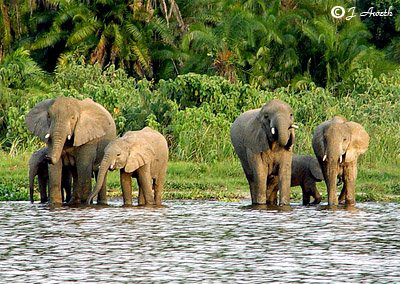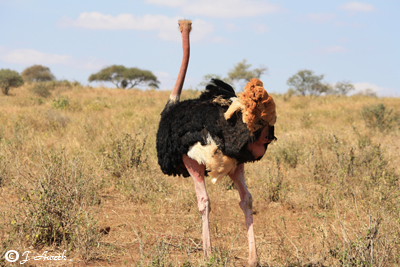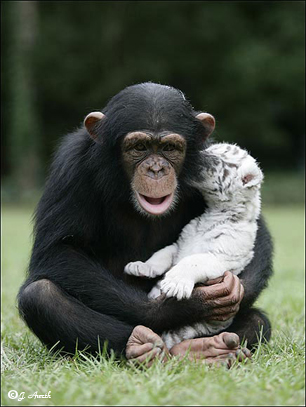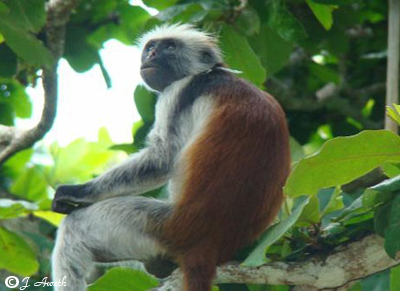GOMBE STREAM
An excited whoop erupts from deep in the forest, boosted immediately by a dozen other voices, rising in volume and tempo and pitch to a frenzied shrieking crescendo. It is the famous ‘pant-hoot’ call: a bonding ritual that allows the participants to identify each other through their individual vocal stylisations. To the human listener, walking through the ancient forests of Gombe Stream, this spine-chilling outburst is also an indicator of imminent visual contact with man’s closest genetic relative: the chimpanzee.
Gombe is the smallest of Tanzania's national parks: a fragile strip of chimpanzee habitat straddling the steep slopes and river valleys that hem in the sandy northern shore of Lake Tanganyika. Its chimpanzees – habituated to human visitors – were made famous by the pioneering work of Jane Goodall, who in 1960 founded a behavioural research program that now stands as the longest-running study of its kind in the world. The matriarch Fifi, the last surviving member of the original community, only three-years old when Goodall first set foot in Gombe, is still regularly seen by visitors. |
 |
Chimpanzees share about 98% of their genes with humans, and no scientific expertise is required to distinguish between the individual repertoires of pants, hoots and screams that define the celebrities, the powerbrokers, and the supporting characters. Perhaps you will see a flicker of understanding when you look into a chimp's eyes, assessing you in return - a look of apparent recognition across the narrowest of species barriers.
The most visible of Gombe’s other mammals are also primates. A troop of beachcomber olive baboons, under study since the 1960s, is exceptionally habituated, while red-tailed and red colobus monkeys - the latter regularly hunted by chimps – stick to the forest canopy.
The park’s 200-odd bird species range from the iconic fish eagle to the jewel-like Peter’s twinspots that hop tamely around the visitors’ centre.
After dusk, a dazzling night sky is complemented by the lanterns of hundreds of small wooden boats, bobbing on the lake like a sprawling city.
KATAVI NATIONAL PARK
Isolated, untrammelled and seldom visited, Katavi is a true wilderness, providing the few intrepid souls who make it there with a thrilling taste of Africa as it must have been a century ago.Tanzania's third largest national park, it lies in the remote southwest of the country, within a truncated arm of the Rift Valley that terminates in the shallow, brooding expanse of Lake Rukwa.
The bulk of Katavi supports a hypnotically featureless cover of tangled brachystegia woodland, home to substantial but elusive populations of the localised eland, sable and roan antelopes. But the main focus for game viewing within the park is the Katuma River and associated floodplains such as the seasonal Lakes Katavi and Chada. During the rainy season, these lush, marshy lakes are a haven for myriad waterbirds, and they also support Tanzania's densest concentrations of hippo and crocodile. |
 |
It is during the dry season, when the floodwaters retreat, that Katavi truly comes into its own. The Katuma, reduced to a shallow, muddy trickle, forms the only source of drinking water for miles around, and the flanking floodplains support game concentrations that defy belief. An estimated 4,000 elephants might converge on the area, together with several herds of 1,000-plus buffalo, while an abundance of giraffe, zebra, impala and reedbuck provide easy pickings for the numerous lion prides and spotted hyena clans whose territories converge on the floodplains.
Katavi's most singular wildlife spectacle is provided by its hippos. Towards the end of the dry season, up to 200 individuals might flop together in any riverine pool of sufficient depth. And as more hippos gather in one place, so does male rivalry heat up – bloody territorial fights are an everyday occurrence, with the vanquished male forced to lurk hapless on the open plains until it gathers sufficient confidence to mount another challenge.
MAHALE MOUNTAINS NATIONAL PARK
Set deep in the heart of the African interior, inaccessible by road and only 100km (60 miles) south of where Stanley uttered that immortal greeting “Doctor Livingstone, I presume”, is a scene reminiscent of an Indian Ocean island beach idyll.
Silky white coves hem in the azure waters of Lake Tanganyika, overshadowed by a chain of wild, jungle-draped peaks towering almost 2km above the shore: the remote and mysterious Mahale Mountains.
Mahale Mountains is home to some of Africa’s last remaining wild chimpanzees: a population of roughly 800 (only 60 individuals forming what is known as "M group"), habituated to human visitors by a Japanese research project founded in the 1960s. Tracking the chimps of Mahale is a magical experience. The guide's eyes pick out last night's nests - shadowy clumps high in a gallery of trees crowding the sky. Scraps of half-eaten fruit and fresh dung become valuable clues, leading deeper into the forest. Butterflies flit in the dappled sunlight.
Then suddenly you are in their midst: preening each other's glossy coats in concentrated huddles, squabbling noisily, or bounding into the trees to swing effortlessly between the vines.
The area is also known as Nkungwe, after the park's largest mountain, held sacred by the local Tongwe people, and at 2,460 metres (8,069 ft) the highest of the six prominent points that make up the Mahale Range. |
 |
And while chimpanzees are the star attraction, the slopes support a diverse forest fauna, including readily observed troops of red colobus, red-tailed and blue monkeys, and a kaleidoscopic array of colourful forest birds.
You can trace the Tongwe people's ancient pilgrimage to the mountain spirits, hiking through the montane rainforest belt – home to an endemic race of Angola colobus monkey - to high grassy ridges chequered with alpine bamboo. Then bathe in the impossibly clear waters of the world’s longest, second-deepest and least-polluted freshwater lake – harbouring an estimated 1,000 fish species - before returning as you came, by boat.
LAKE TANGANYIKA
This vast inland sea was first made known to the European world in the mid 1800’s by the English explorers Richard Burton and John Speke. They pursued it as the source of the Nile, arriving at its shores in February of 1858, only to discover that the Ruzizi River in the north, which they thought to be the Nile, flowed into and not out of the lake. (Their incredible journey is documented in the movie ‘Mountains of the Moon’.)
| Tanganyika's waters lap Tanzania, Burundi, Congo DR and Zambia. It is the longest fresh water lake in the world and the second deepest after lake Baikal in Russia. The immense depth is because it lies in the Great Rift Valley, which also has created its steep shoreline. It reaches a depth of 1433 metres (4 700 feet), which is an astounding 642m below sea level.
Although Zambia can only lay claim to 7% of its surface area, it stretches north to south a distance of 677 kilometres (420 miles) and averages about fifty kilometers wide (31 miles). The clear waters host more than 350 different species of fish and is well known for aquarium fish exports and excellent angling. The fertile circulating surface water, although not tidal, provides abundant plankton for its inhabitants which in turn provides much needed protein for both the local and export markets. The stiff winds that blow off the surrounding mountains aid the continual movement which inhibits the spread of bilharzia, the parasitic disease carried by shallow water snails. |

|
A pair of fish eagles guards the gentle bay, their distinctive black, white and chestnut feather pattern gleaming boldly in the morning sun. Suddenly, the birds toss back their heads in a piercing, evocative duet. On the sandbank below, a well-fed monster of a crocodile snaps to life, startled from its nap. It stampedes through the crunchy undergrowth, crashing into the water in front of the boat, invisible except for a pair of sentry-post eyes that peek menacingly above the surface to monitor our movements.
RUBONDO ISLAND
Rubondo Island is tucked in the southwest corner of Lake Victoria, the world's second-largest lake, an inland sea sprawling between Tanzania, Uganda and Kenya. With nine smaller islands under its wing, Rubondo protects precious fish breeding grounds.
Tasty tilapia form the staple diet of the yellow-spotted otters that frolic in the island's rocky coves, while rapacious Nile perch, some weighing more than 100kg, tempt recreational game fishermen seeking world record catches.
Rubondo is more than a water wonderland. Deserted sandy beaches nestle against a cloak of virgin forest, where dappled bushbuck move fleet yet silent through a maze of tamarinds, wild palms, and sycamore figs strung with a cage of trailing taproots. The shaggy-coated aquatic sitatunga, elsewhere the most elusive of antelopes, is remarkably easily observed, not only in the papyrus swamps it normally inhabits, but also in the forest interior. |
 |
Birds are everywhere. Flocks of African grey parrots – released onto the island after they were confiscated from illegal exporters – screech in comic discord as they flap furiously between the trees.
The azure brilliance of a malachite kingfisher perched low on the reeds competes with the glamorous, flowing tail of a paradise flycatcher as it flits through the lakeshore forest. Herons, storks and spoonbills proliferate in the swampy lake fringes, supplemented by thousands of Eurasian migrants during the northern winter.
Wild jasmine, 40 different orchids and a smorgasbord of sweet, indefinable smells emanate from the forest.
Ninety percent of the park is humid forest; the remainder ranges from open grassland to lakeside papyrus beds.
A number of indigenous mammal species - hippo, vervet monkey, genet and mongoose - share their protected habitat with introduced species such as chimpanzee, black-and-white colobus, elephant and giraffe, all of which benefit from Rubondo's inaccessibility. |
